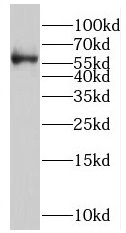产品
RORC antibody
| 别称: | Nuclear receptor ROR-gamma|Nuclear receptor RZR-gamma|Nuclear receptor subfamily 1 group F member 3|RAR-related orphan receptor C|Retinoid-related orphan receptor-gamma|RORC|NR1F3|RORG|RZRG antibody | ||
| 货号: | FNab07389 | 反应性: | Human, Mouse, Rat |
| 宿主: | Rabbit | 验证实验: | ELISA, WB |
| 克隆性: | polyclonal | 亚型: | IgG |
| 规格 | 价格 |
|---|---|
| 100μg | RMB ¥1900 |
| 50μg | RMB ¥1140 |
- 产品介绍
- 实验结果
- 实验条件
- 常见问题
- 产品名称
- RORC antibody
- 货号
- FNab07389
- 规格
- 100μg
- 状态
- liquid
- 纯化方法
- Immunogen affinity purified
- 纯度
- ≥95% as determined by SDS-PAGE
- 克隆性
- polyclonal
- 亚型
- IgG
- 存储
- PBS with 0.02% sodium azide and 50% glycerol pH 7.3, -20℃ for 12 months(Avoid repeated freeze / thaw cycles.)
- 免疫原
- RAR-related orphan receptor C
- 别称
- Nuclear receptor ROR-gamma|Nuclear receptor RZR-gamma|Nuclear receptor subfamily 1 group F member 3|RAR-related orphan receptor C|Retinoid-related orphan receptor-gamma|RORC|NR1F3|RORG|RZRG antibody
- UniProt ID
- P51449
- 分子量
- 58 kDa
- 验证实验
- ELISA, WB
- 建议稀释比例
- WB: 1:500 - 1:2000
 Jurkat cells were subjected to SDS PAGE followed by western blot with FNab07389(RORC antibody) at dilution of 1:1000
Jurkat cells were subjected to SDS PAGE followed by western blot with FNab07389(RORC antibody) at dilution of 1:1000
- 背景介绍
- Nuclear receptor that binds DNA as a monomer to ROR response elements(RORE) containing a single core motif half-site 5'-AGGTCA-3' preceded by a short A-T-rich sequence. Key regulator of cellular differentiation, immunity, peripheral circadian rhythm as well as lipid, steroid, xenobiotics and glucose metabolism(PubMed:19381306, PubMed:19965867, PubMed:22789990, PubMed:26160376, PubMed:20203100). Considered to have intrinsic transcriptional activity, have some natural ligands like oxysterols that act as agonists(25-hydroxycholesterol) or inverse agonists(7-oxygenated sterols), enhancing or repressing the transcriptional activity, respectively(PubMed:19965867, PubMed:22789990). Recruits distinct combinations of cofactors to target gene regulatory regions to modulate their transcriptional expression, depending on the tissue, time and promoter contexts. Regulates the circadian expression of clock genes such as CRY1, ARNTL/BMAL1 and NR1D1 in peripheral tissues and in a tissue-selective manner. Competes with NR1D1 for binding to their shared DNA response element on some clock genes such as ARNTL/BMAL1, CRY1 and NR1D1 itself, resulting in NR1D1-mediated repression or RORC-mediated activation of the expression, leading to the circadian pattern of clock genes expression. Therefore influences the period length and stability of the clock. Involved in the regulation of the rhythmic expression of genes involved in glucose and lipid metabolism, including PLIN2 and AVPR1A(PubMed:19965867). Negative regulator of adipocyte differentiation through the regulation of early phase genes expression, such as MMP3. Controls adipogenesis as well as adipocyte size and modulates insulin sensitivity in obesity. In liver, has specific and redundant functions with RORA as positive or negative modulator of expression of genes encoding phase I and Phase II proteins involved in the metabolism of lipids, steroids and xenobiotics, such as SULT1E1. Also plays also a role in the regulation of hepatocyte glucose metabolism through the regulation of G6PC and PCK1(PubMed:19965867). Regulates the rhythmic expression of PROX1 and promotes its nuclear localization(PubMed:19381306, PubMed:19965867, PubMed:22789990, PubMed:26160376, PubMed:20203100). Plays an indispensable role in the induction of IFN-gamma dependent anti-mycobacterial systemic immunity(PubMed:26160376). Isoform 2: Essential for thymopoiesis and the development of several secondary lymphoid tissues, including lymph nodes and Peyer's patches. Required for the generation of LTi(lymphoid tissue inducer) cells. Regulates thymocyte survival through DNA-binding on ROREs of target gene promoter regions and recruitment of coactivaros via the AF-2. Also plays a key role, downstream of IL6 and TGFB and synergistically with RORA, for lineage specification of uncommitted CD4(+) T-helper(T(H)) cells into T(H)17 cells, antagonizing the T(H)1 program. Probably regulates IL17 and IL17F expression on T(H) by binding to the essential enhancer conserved non-coding sequence 2(CNS2) in the IL17-IL17F locus. May also play a role in the pre-TCR activation cascade leading to the maturation of alpha/beta T-cells and may participate in the regulation of DNA accessibility in the TCR-J(alpha) locus.
抗体可以回收利用几次?
一般抗体不推荐回收利用,抗体使用之后缓冲体系已经发生改变,不同客户在回收抗体的保存条件上也会有差异,所以抗体回收使用效果无法保证。
FineTest公司也做过一批抗体回收验证测试,测试结果显示不同抗体可回收次数不同,一般效价越高的抗体,可重复使用的次数越多,客户可根据实验情况来确定。
注:我们将孵育完毕后剩余的抗体回收到离心管中置于4℃保存,效价高的抗体可至少保存1周,重复利用3次左右。
FineTest公司抗体buffer成分是什么?
FineTest抗体成分一般是PBS含proclin300或sodium azide、BSA、50%甘油;也有一些是PBS含proclin300或sodium azide,50%甘油。防腐剂proclin300或sodium azide是常用的防腐剂,广泛应用于实验室和工业中。
FineTest公司抗体的保存温度和时间?
大部分抗体是放在-20℃保存,直标流式抗体需要放在2-8℃保存,质保期一年,质保期内抗体出现售后,可进行退货或换货。
一般抗体超过一年质保期仍旧可以使用,我们可以提供技术支持服务。
FineTest公司抗体使用需要稀释吗?用什么溶液稀释?
除了直标流式抗体为即用型,不用稀释。其他抗体一般为浓缩型,使用时需要按照说明书建议稀释比例稀释。
不同实验使用的稀释液不同,用PBST, TBST, 抗体封闭液等常用抗体稀释液均可。
免疫组化实验抗体的修复方式?
常用修复液:Tris-EDTA缓冲液(Tris-EDTA Buffer, pH 9.0);柠檬酸盐缓冲液(Citrate Buffer, pH 6.0)
热修复:
方法1:沸水浴修复,将盛有修复液和玻片的烧杯置于沸水浴环境,保持外部沸腾状态15min,自然冷却至室温;
方法2:微波修复,将盛有修复液和玻片的烧杯置于微波炉中,高火5min,停火3min,中火5min,自然冷却至室温。
如何选择二抗?
(1)二抗是和一抗反应的,所以二抗必须是抗一抗宿主物种,比如一抗来源于兔,对应二抗则选择抗兔二抗,比如羊抗兔或驴抗兔。
(2)根据实验类型选择二抗偶联物,比如做ELISA, 蛋白质印迹,IHC实验,常用酶联二抗,如HRP,AP等标记。而免疫荧光实验,流式细胞术实验中,则用荧光蛋白或染料标记,比如FITC,Cy3等。














